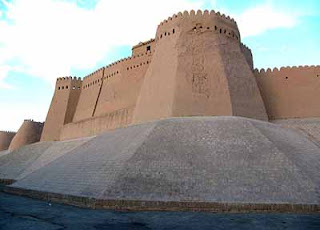The next morning I wended my way through the streets of the Old City, heading westward toward the Ata Darzava, or Master Gate. As I mentioned, the Old City is one vast museum, with people living within it. Early risers like myself can see many families, all in their pajamas, sleeping on their front porches, enjoying the fresh night air. Out of respect for the privacy of these people I will not include photos.
Street in the Old City
Just to the east of the Master Gate and in front of the Muhammad Amin Khan Madrasa is the Kalta Minaret, also known as the Guyok (Green) Minaret. The Khivan Ruler Muhammad Amin Khan ordered its construction in the early 1850s. According to plan, this was to be the grandest minaret in Transoxiania, with a height of 70 to 80 meters (230 to 262 feet), but it was not finished when the Khan died in 1855. There are two legends as to why the minaret was not completed. One says that the Khan halted construction after he suddenly realized that anyone on the top of the minaret would be able to peer down into his harem and see his wives. Another legend maintains that when the Amir of Bukhara found out about the minaret he made a secret agreement with the architect to build an even taller one in Bukhara. Somehow Muhammad Amin Khan found out about this and he issued a secret order that the architect was to be killed as soon as the minaret was completed. This order somehow reached the ears of the architect and he fled the city while construction was still taking place. In any case, the minaret was never finished. It is now 29 meters (95 feet) high, with bottom diameter of 11.2 meters (37 feet).
The truncated Kalta Minaret
Another view of the mineret
The minaret is connected to the Muhammad Amin Khan Madrasa (School), built 1851–55.
Shops in front of the minaret and madrasa
The minaret and madrasa from the top of the Citadel



























